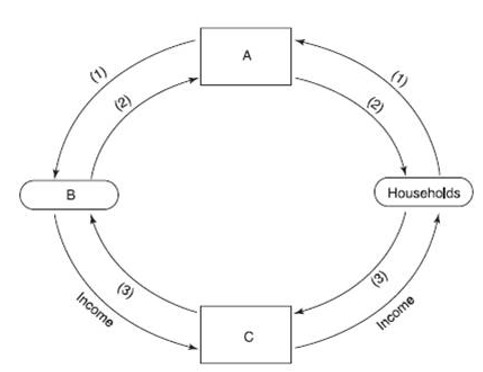A) the degree of scarcity it faces.
B) the way in which basic economic decisions are made.
C) the forms into which its businesses are legally organized.
D) its type of government; that is, whether it has a dictatorship or a democracy.
Correct Answer

verified
Correct Answer
verified
Multiple Choice
Market failure occurs when:
A) a small number of sellers dominate a market.
B) buyers have inadequate information to make economic decisions.
C) cost-minimizing decisions by businesses create problems for society.
D) all of the above.
Correct Answer

verified
Correct Answer
verified
Multiple Choice
On the basis of the following continuum, economic changes in Eastern Europe, the former Soviet Union, and China since the mid-1980s would be most appropriately 
A) A to point
B) B to point A.
C) B to point C.
D) D to point B.
Correct Answer

verified
Correct Answer
verified
True/False
Society often turns to the government to correct a market failure.
Correct Answer

verified
Correct Answer
verified
True/False
There is no difference between a market economy and a planned economy in how income is distributed.
Correct Answer

verified
Correct Answer
verified
Multiple Choice
In the circular flow model:
A) resources go from businesses to households in input markets.
B) income flows to households from businesses in output markets.
C) households are buyers and businesses are sellers in input markets.
D) businesses are sellers and households are buyers in output markets.
Correct Answer

verified
Correct Answer
verified
Multiple Choice
During President George W. Bush's and President Barack Obama's administrations:
A) the national debt continued to decline.
B) health care spending which had been increasing for years began to fall.
C) future funding for Social Security no longer was an issue with increased contributions.
D) the trend toward less government intervention during the Bush administration was reversed with the Obama administration.
Correct Answer

verified
D
Correct Answer
verified
Multiple Choice
Which of the following is an example of market failure?
A) Workers are treated unequally because of race, gender, or other discrimination.
B) Buyers lack adequate information to make knowledgeable decisions about which goods and services to purchase.
C) Competition drives sellers out of markets, leaving buyers with fewer sellers from whom to purchase and causing them to pay higher prices.
D) All of the above.
Correct Answer

verified
D
Correct Answer
verified
Multiple Choice
Economies that rely on historical, social, political, or religious arrangements are classified as:
A) mixed economies.
B) market economies.
C) planned economies.
D) traditional economies.
Correct Answer

verified
Correct Answer
verified
Multiple Choice
The idea of individual decision making popularized by Adam Smith in the late 1700s provided the foundation for:
A) mercantilism.
B) U.S. capitalism.
C) Chinese socialism.
D) the economy of the former Soviet Union.
Correct Answer

verified
B
Correct Answer
verified
Multiple Choice
The "dark side"of the Industrial Revolution included all of the following EXCEPT:
A) low pay.
B) long hours.
C) poor working conditions.
D) exclusion of women and children from the workforce.
Correct Answer

verified
Correct Answer
verified
Multiple Choice
Market economies tend to produce goods and services efficiently because:
A) profit incentives are a driving force behind business production decisions.
B) information required for production decisions passes directly between buyers and sellers via prices.
C) both of the above.
D) none of the above.
Correct Answer

verified
Correct Answer
verified
Multiple Choice
In a planned economy:
A) free enterprise is the prevailing philosophy.
B) goods and services are usually produced more efficiently than in a market system.
C) value judgments of individual buyers and sellers are more important than value judgments of planners.
D) how goods and services are produced is determined by what resources planners make available to producers.
Correct Answer

verified
Correct Answer
verified
Multiple Choice
An assumption of laissez-faire capitalism is that the wealth of a nation will be increased:
A) by maintaining minimal government interference in its economy.
B) by relying on free and open competition to regulate business dealings.
C) if individuals are left relatively free to pursue their economic interests.
D) all of the above.
Correct Answer

verified
Correct Answer
verified
Multiple Choice
By producing its product using the least-cost method, a seller is:
A) using the smallest number of resources.
B) necessarily producing the poorest quality product.
C) producing in the way that allows for the greatest profit.
D) all of the above.
Correct Answer

verified
Correct Answer
verified
Multiple Choice
The granting to individuals the property rights to factors of production that were once collectively owned, or owned by the state, is:
A) referred to as privatization.
B) an important element in the transformation from a planned to a market economy.
C) necessary if individuals, rather than the state, are to organize resources and take risks.
D) all of the above.
Correct Answer

verified
Correct Answer
verified
True/False
In a planned economy, economic decisions are made by individual buyers and sellers.
Correct Answer

verified
Correct Answer
verified
Multiple Choice
Since the mid-1980s, many economies such as the Soviet Union and China have:
A) closed their markets and have relied more heavily on government planning.
B) been relying more on free markets.
C) curtailed the use of private property rights.
D) pushed for more state control over what goods and services should be produced.
Correct Answer

verified
Correct Answer
verified
Multiple Choice
Circular flow model.
 -In a pure market economy, the government would be represented by:
-In a pure market economy, the government would be represented by:
A) box A.
B) box C.
C) boxes A and C.
D) none of the above.
Correct Answer

verified
Correct Answer
verified
Multiple Choice
In a circular flow model of a market economy, households:
A) sell goods to businesses in input markets.
B) buy goods from businesses in input markets.
C) sell resources to businesses in input markets.
D) buy resources from businesses in input markets.
Correct Answer

verified
Correct Answer
verified
Showing 1 - 20 of 215
Related Exams